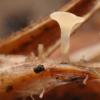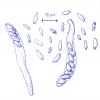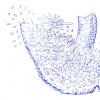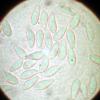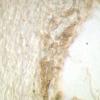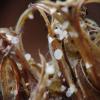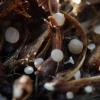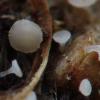
24-12-2025 17:08
Hulda Caroline HolteHello, I have found this propoloid ascomycete on

21-12-2025 09:32
Hello.A tiny ascomycete found embedded in wood in

21-12-2025 21:32
Pol DebaenstHello, Garden, Burgweg 19, Veurne, BelgiumOn 10/1

22-12-2025 23:38
Patrice TANCHAUDBonsoir, récolte sur un mur en pierre, apothéci

22-12-2025 00:47
Patrice TANCHAUDBonsoir, récolte à proximité du milieu dunaire
Crocicreas amenti?
Dmitry Gavryushin,
20-01-2007 13:14
Perz Piotr,
20-01-2007 13:51
Re:Crocicreas amenti?
Yeah, C.amenti.
Hans-Otto Baral,
20-01-2007 21:15

Re:Crocicreas amenti?
I don´t think so. P. amenti has shorter stalks of apothecia and spores have a different shape, broader, strongly clavate. No idea!
Perz Piotr,
20-01-2007 21:27
Hans-Otto Baral,
20-01-2007 23:41

Re:Crocicreas amenti?
Your spores, Piotr, are not even so different from Dmitrij´s. To clarify the identity of this nice fungus, it is necessary to see the contents of the living paraphyses. In C. amenti they are filled with strongly refractive guttules (VBs). In other genera like Allophylaria the contents are elongate as in Mollisia. Also we should know the IKI reaction and shape of the apical ring.
Zotto
Zotto
Perz Piotr,
20-01-2007 23:59
Perz Piotr,
21-01-2007 00:50
Hans-Otto Baral,
21-01-2007 17:12

Re:Crocicreas amenti?
Thanks for the very good help, Piotr! The stalk is longer than I had in mind. So it could well be amenti, what else...
Zotto
Zotto
Dmitry Gavryushin,
22-01-2007 09:15
Re:Crocicreas amenti?
Thanks a lot Piotr and Zotto - I still have some specimens, so maybe I should take a closer look...
Perz Piotr,
22-01-2007 09:20
Re:Crocicreas amenti?
Hi Dmitry,
the guttules are visible only in LIVING cells, so you should collect a new Apos and take a look in vital state.
the guttules are visible only in LIVING cells, so you should collect a new Apos and take a look in vital state.
